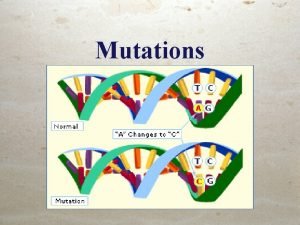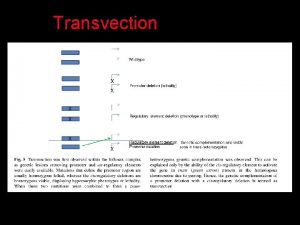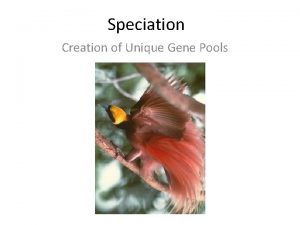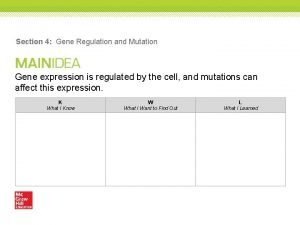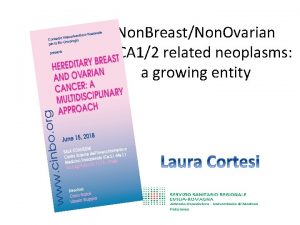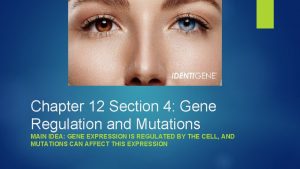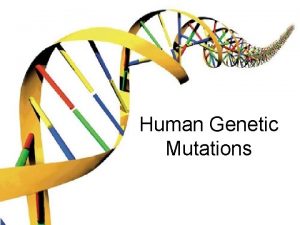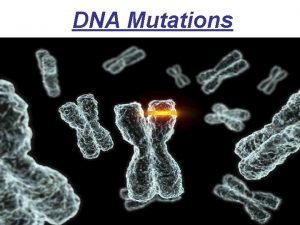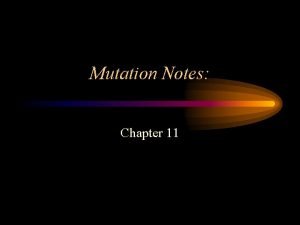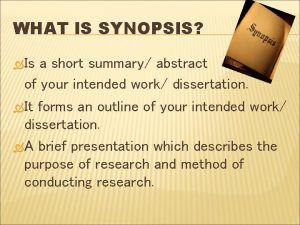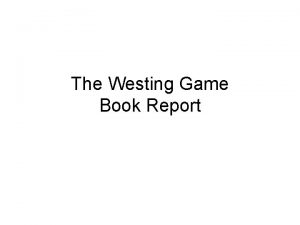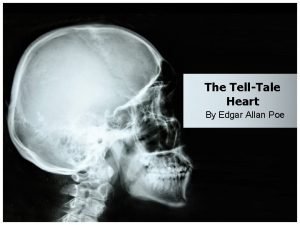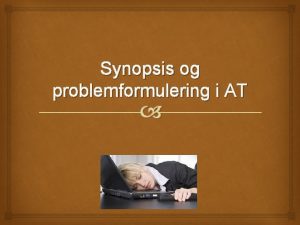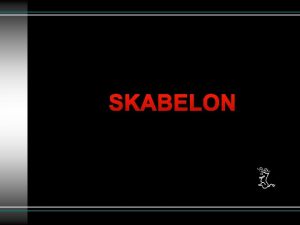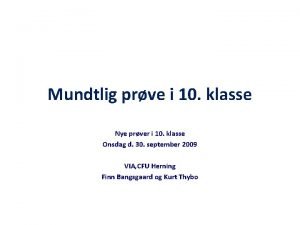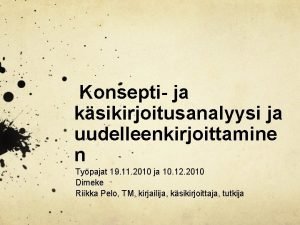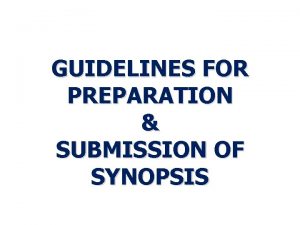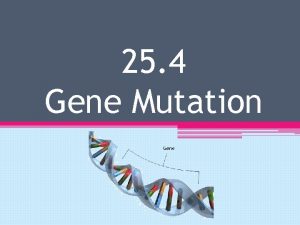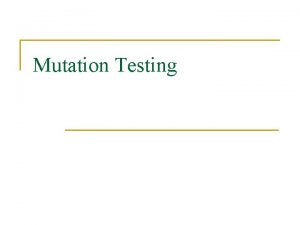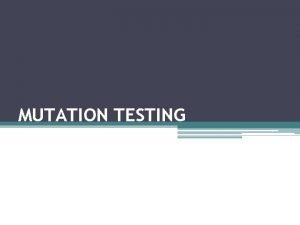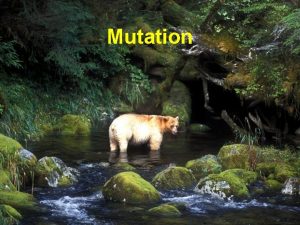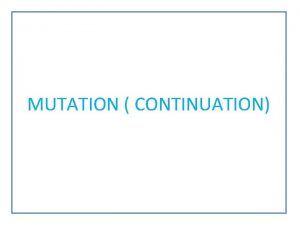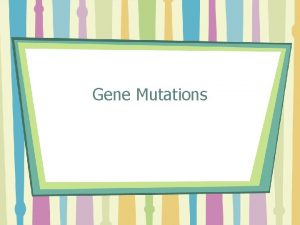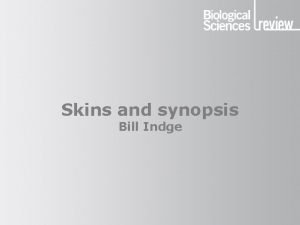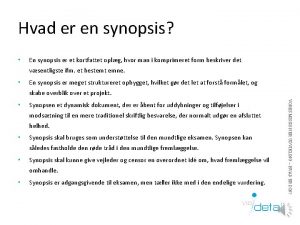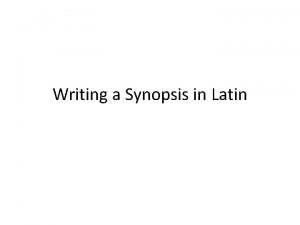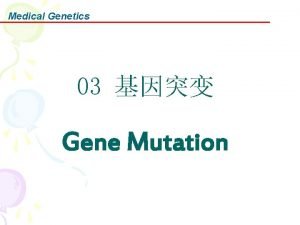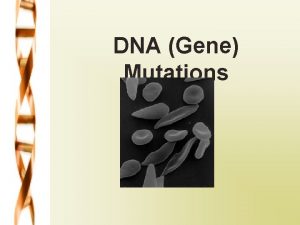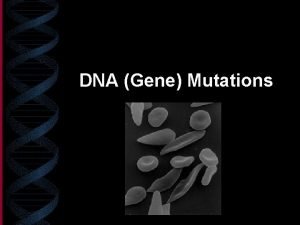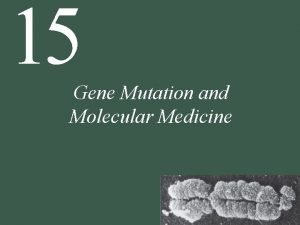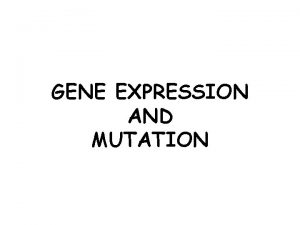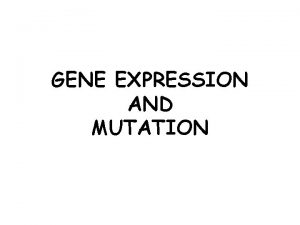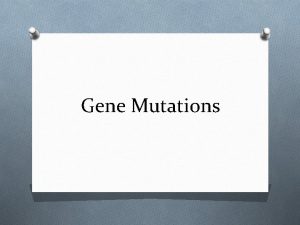SYNOPSIS INTRODUCTION HISTORY TYPES OF MUTATION GENE MUTATION

























- Slides: 25


SYNOPSIS • • • INTRODUCTION HISTORY TYPES OF MUTATION GENE MUTATION TYPES OF GENE MUTATION MOLECULAR MECHANISM OF GENE MUTATION EFFECT OF GENE MUTATION RECENT RESEARCH REFERENCES

INTRODUCTION • MUTATION- Any sudden change occurring in hereditary material is called as mutation. • They may be harmful, beneficial or neutral. • DNA is highly stable molecule that replicates with amazing accuracy some errors of replication do occur. http: //www. nature. com/scitable/topicpage/geneticmutation 1127

HISTORY • 1901: Hugo de Vries first used the term mutation to describe the sudden heritable phenotypic changes in evening primrose Oenothera lamarckiana. • 1904: T. H. Morgan reported white eyed drosophila in the population of red eyed flies. • 1928: H. J. Muller first used x-rays to induce mutation in fruit fly. Thomas Hunt Morgan Masatoshi and Masafumi, 2011

TYPES OF MUTATION www. biologyisfun. com

GENE MUTATION • A gene mutation is defined as an alteration in the sequence of nucleotides in DNA. • This change can affect a single nucleotide pair or larger gene segment of a chromosome. Gardner et al. , 2011

TYPES OF GENE MUTATION Point mutation • Silent mutation Frame shift mutation Base substitution mutation • Insertion • Transition mutation • Deletion • Transversion mutation • Missense mutation • Nonsense mutation www. biologyisfun. com

POINT MUTATION Point mutations are the most common type of gene mutation. Also known as base pair substitution. Change in a single nucleotide base pair. Point mutation can be categorized into three types: Silent mutation Missense mutation Nonsense mutation https: //ghr. nlm. nih. gov/mutationsandhealth

SILENT MUTATION The change in one codon for an amino acid into another codon for that same amino acid. Silent mutations are also referred to as synonymous mutations. Griffiths et al. , 2002

MISSENSE MUTATION The codon for one amino acid is changed into a codon for another amino acid. Missense mutations are sometimes referred to as non-synonymous mutations. Griffiths et al. , 2002

NONSENSE MUTATION The codon for one amino acid is changed into a translation termination (stop) codon. Krebs et al. , 2011

FRAME SHIFT MUTATIONS • This type of mutation occurs when the addition or loss of DNA bases changes a gene' s reading frame. A reading frame consists of 3 bases, each code for one amino acid. • A frame shift mutation shifts the grouping of these bases and changes the code for amino acids. • The resulting protein is usually nonfunctional. Insertions and deletion can all be frame shift mutations. Gardner et al. , 2011

FRAMESHIFT MUTATIONS https: //ghr. nlm. nih. gov/mutationsandhealth

INSERTION An insertion changes the number of DNA bases in a gene by adding a piece of DNA. As a result, the protein coded by the gene may not function properly. https: //ghr. nlm. nih. gov/mutationsandhealth

DELETION • A deletion changes the number of DNA bases by removing a piece of DNA. • Small deletion may remove one or few base pairs within a gene. • Larger deletions can remove one entire gene or several neighboring genes. The deleted DNA may alter the function of the resulting protein. krebs et al. , 2011

BASE SUBSTITUTION MUTATION Base substitution are mutation in which one base pair is replaced by another. Base substitutions can be divide into two subtype transition mutation transversion mutation Griffiths et al. , 2002

TRANSITION MUTATION A transition is the replacement of a base by the other base of the same chemical. Griffiths et al. , 2002

TRANSVERSION MUTATION A transversion is the opposite the replacement of a base of one chemical category by a base of the other. Griffiths et al. , 2002

MOLECULAR MECHANISM OF MUTATION • Spontaneous mutation Tautomerism Depurination Deamination • Induced mutation Physical mutagens Radiation a. Ionizing b. Non ionizing Heat Chemical mutagens Base analogs, alkylating agent, intercalating agent https: //ghr. nlm. nih. gov/mutationsandhealth

SPONTANEOUS MUTATION Spontaneous mutation are those which arise naturally, not through the action of a mutagenic agent, they may arise through Errors in DNA replication Spontaneous alteration of a nucleotide within an existing DNA molecule. Malacinski and Freifelder, 1998

SPONTANEOUS MUTATION • Tautomerism- A base is changed by the repositioning of a hydrogen atom, altering the hydrogen bonding pattern of that bases, resulting in an incorrect base pairing replication. • Depurination- Loss of purine base (A or G) to form an apurinic site. • Deamination- Hydrolysis changes a normal base to an a typical base containing a keto group in place of the original amino acid. Malacinski and Freifelder, 1998

INDUCED MUTATION During its lifetime, an organism may be exposed to a variety of physical, chemical, and biological agents capable of causing damage to its genetic material Physical mutagens Radiation a. Ionizing (e. g. X-ray, gamma ray, cosmic ray) b. Non ionizing (e. g. UV ray) Heat a. Break the N-glycosidic bond in DNA b. Result form apurinic site or base less site Chemical mutagens a. Base analogs b. Alkylating agent c. Intercalating agent Malacinski and Freifelder, 1998

EFFECTS OF GENE MUTATION Effects Beneficial • Produce new version of protein • Essential for evolution • Enhance the survival and reproductive success • Turn off harmful genes Harmful Neutral • Protein malfunction • Lethal to life • Sometimes stops the development of fetus. • Not significantly harm or benefit body • Cause genetic disorder https: //ghr. nlm. nih. gov/mutationsandhealth

GENETIC DISORDER • Mutation can lead to missing or malformed proteins that can lead to diseases. • Some well known inherited genetic disorders Sickle cell anemia Cancer • All these disorders are caused by the mutation of a single gene. http: //genetics. thetech. org/about-genetics/mutations-and-diseases

 Mutation is any mistake or change in the
Mutation is any mistake or change in the Hox gene mutation in drosophila
Hox gene mutation in drosophila Hox gene mutation in drosophila
Hox gene mutation in drosophila Section 4 gene regulation and mutation
Section 4 gene regulation and mutation Brca gene mutation
Brca gene mutation Chapter 12 section 4: gene regulation and mutations
Chapter 12 section 4: gene regulation and mutations Gene by gene test results
Gene by gene test results Protein power point
Protein power point Types of chromosomal mutations
Types of chromosomal mutations 4 types of mutations
4 types of mutations Chromosome mutation types
Chromosome mutation types Chromosome mutation types
Chromosome mutation types Abstract or synopsis
Abstract or synopsis To kill a mockingbird chapter 5 summary
To kill a mockingbird chapter 5 summary Westing game book summary
Westing game book summary Summary of tell tale heart
Summary of tell tale heart A summary of the tell tale heart
A summary of the tell tale heart Punished by his love chapter 1201
Punished by his love chapter 1201 Workshop synopsis examples
Workshop synopsis examples Gode problemformuleringer eksempler
Gode problemformuleringer eksempler Sitcom
Sitcom Skabelon til problemformulering
Skabelon til problemformulering Paradise lost synopsis
Paradise lost synopsis Dansk mundtlig eksamen 9 klasse oplæsning
Dansk mundtlig eksamen 9 klasse oplæsning Summary macbeth act 4
Summary macbeth act 4 Synopsis esimerkki
Synopsis esimerkki
